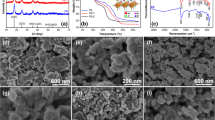Abstract
As part of an effort to build a prototype flow battery system using a nano-suspension containing β-Ni(OH)2 nanoparticles as the cathode material, nanosized β-Ni(OH)2 particles with well-controlled particle size and morphology were synthesized via the one-step precipitation of a NiCl2 precursor. The composition and morphology of the nanoparticles were characterized by scanning electronic microscopy (SEM) and X-ray diffraction (XRD). The XRD patterns confirmed that β-Ni(OH)2 was successfully synthesized, while SEM results showed that the particle sizes range from 70 to 150 nm. To ensure that Ni(OH)2 could be employed in the nano-suspension flow battery, the electrochemical performance of the synthesized β-Ni(OH)2 was initially tested in pouch cells through charge/discharge cycling. The phase transformations occurring during charge/discharge were investigated using in-situ X-ray absorption spectroscopy to obtain the shift in the oxidation state of Ni (X-ray adsorption near edge structure, XANES) and the distances between Ni and surrounding atoms in charged and discharged states (extended X-ray absorption fine structure, EXAFS). XANES results indicated that the electrode in the discharged state was a mixture of phases because the edge position did not shift back completely. XAFS results further proved that the discharge capacity was provided by β-NiOOH and the ratio between β-Ni(OH)2 and γ-NiOOH in the electrode in the discharged state was 71:29. Preliminary nano-suspension tests in a lab-scale cell were conducted to understand the behavior of the nanosuspension during charge/discharge cycling and to optimize the operating conditions.
Similar content being viewed by others
References
Zhou H, Zhou Z. Effects of ultrasonic treatment on the structure and electrochemical performance of spherical ß-Ni(OH)2. Chinese Journal of Chemistry, 2006, 24(1): 37–44
Shuka A K, Venugopalah S, Hariprakash B. Nickel-based rechargeable batteries. Journal of Power Sources, 2001, 100(1–2): 125–148
Freitas M B J G. Nickel hydroxide powder for NiOOH/Ni(OH)2 electrodes of the alkaline batteries. Journal of Power Sources, 2001, 93(1–2): 163–173
Xu P, Han X, Zhang B, Lv Z, Liu X. Characterization of an ultrafine nickel hydroxide from supersonic co-precipitation method. Journal of Alloys and Compounds, 2007, 436(1–2): 369–374
Cheng J, Zhang L, Yang Y, Wen Y, Cao G, Wang X. Preliminary study of single flow zinc-nickel battery. Electrochemistry Communications, 2007, 9(11): 2639–2642
Jia C, Pan F, Zhu Y, Huang Q, Lu L, Wang Q. High-energy density nonaqueous all redox flow lithium battery enabled with a polymeric membrane. Science Advances, 2015, 1(10): e1500886
Pan J, Sun Y, Wan P, Wang Z, Liu X. Synthesis, characterization and electrochemical performance of battery grade NiOOH. Electrochemistry Communications, 2005, 7(8): 857–862
Guan X, Deng J. Preparation and electrochemical performance of nano-scale nickel hydroxide with different shapes. Materials Letters, 2007, 61(3): 621–625
Han X, Xu P, Xu C, Zhao L, Mo Z, Liu T. Study of the effects of nanometer b-Ni(OH)2 in nickel hydroxide electrodes. Electrochimica Acta, 2005, 50(14): 2763–2769
Köhler U, Antonius C, Bauerlein P. Advances in alkaline batteries. Journal of Power Sources, 2004, 127(1–2): 45–52
Liu X, Yu L. Synthesis of nanosized nickel hydroxide by solid-state reaction at room temperature. Materials Letters, 2004, 58(7–8): 1327–1330
Losev A V, Petrii O A. Effect of the aggregate stability of a suspension on the rate of charge transfer from the current collector of the suspension electrode to suspension particles. Elektrokhimiya, 1976, 12: 1749
Garche J, Dietz H, Wiesener K. The suspension electrode technique for electrochemical analysis of lead dioxide. Journal of Electroanalytical Chemistry and Interfacial Electrochemistry, 1984, 180 (1–2): 577–585
Duduta M, Ho B, Wood V C, Limthongkul P, Brunini V E, CarterW C, Chiang Y M. Semi-solid lithium rechargeable flow battery. Advanced Energy Materials, 2011, 4(1): 551–556
Kumbur E C, Gogotsi Y. Composite manganese oxide percolating networks as a suspension electrode for an asymmetric flow capacitor. ACS Applied Materials & Interfaces, 2014, 6(11): 8886–8893
Pandya K I, O’Grady W E, Corrigan D A, McBreen J, Hoffman R W. Extended X-ray absorption fine structure investigation of nickel hydroxides. Journal of Physical Chemistry, 1990, 94(1): 21–26
Ichiyanagi Y, Kondoh H, Yokoyama T, Okamoto K, Nagai K, Ohta T. X-ray absorption fine-structure study on the Ni(OH)2 monolayer nanoclusters. Chemical Physics Letters, 2003, 379(3–4): 345–350
Farley N R S, Gurman S J, Hillman A R. In-situ EXAFS study of nickel hydroxide electrodes during discharge. Journal of Synchrotron Radiation, 1999, 6(3): 198–200
Morishita M, Ochiai S, Kakeya T, Ozaki T, Kawabe Y, Watada M, Tanase S, Sakai T. Phase transformation in the charge-discharge process and the structural analysis by synchrotron XAFS and XRD for nickel hydroxide electrode. Electrochemistry, 2008, 76(11): 802–807
Zimmerman A H. Mechanisms for capacity fading in the NiH2 cell and its effects on cycle life. The 1992 NASA Aerospace Battery Workshop. NASA CP-3102, 1993, 153–175
Tessier C, Haumesser P H, Bernard P, Delmas C. The structure of Ni(OH)2: from the ideal material to the electrochemically active one. Journal of the Electrochemical Society, 1999, 146(6): 2059–2067
Acknowledgements
This research was funded by US Department of Energy, Advanced Research Funding Agency — Energy (ARPA-E) award #AR000387. MRCAT operations are supported by the Department of Energy and the MRCAT member institutions. Use of the Argonne National Laboratory, Advanced Photon Source and Electron Microscopy Center are supported by the U.S. Department of Energy, under Contract No. DE-AC02-06CH113.
Author information
Authors and Affiliations
Corresponding author
Rights and permissions
About this article
Cite this article
Li, Y., He, C., Timofeeva, E.V. et al. β-Nickel hydroxide cathode material for nano-suspension redox flow batteries. Front. Energy 11, 401–409 (2017). https://doi.org/10.1007/s11708-017-0496-0
Received:
Accepted:
Published:
Issue Date:
DOI: https://doi.org/10.1007/s11708-017-0496-0




